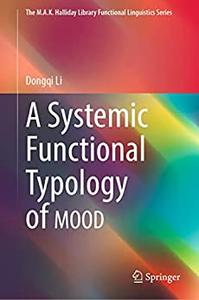
Free Download A Systemic Functional Typology of MOOD
English | 2023 | ISBN: 981198820X | 553 Pages | PDF EPUB (True) | 22 MB
The grammatical category of (sentence) mood has been of central interest to many branches of linguistics, including linguistic typology and systemic functional linguistics. This book is a successful integration of the typological and systemic functional approaches to mood, aiming to investigate the commonalities and variations across languages in both mood system and mood structure. To this aim, it establishes a geographically, genetically and typologically representative sample of 60 languages and provides detailed systemic functional descriptions of the mood system and mood structure of these languages. Based on such descriptions, it makes cross-linguistic comparisons of the mood system and mood structure of the languages in the sample. Structurally, it explores the cross-linguistic commonalities and variations in (i) the realizations of some major functional elements in mood structure, (ii) the realizations of mood options and (iii) the realizations of mood system. Systemically, it investigates how languages resemble and vary from each other in (i) the subtypes of major mood types, (ii) the organization of mood system and (iii) the semantic dimensions along which mood system is elaborated further in delicacy. Moreover, building on the descriptions and comparisons, it makes some generalizations about the structural and systemic features of mood and proposes some tentative explanations for the commonalities and variations languages display in mood system and mood structure. This book is an empirical and holistic approach to the typology of mood and contributes to a deeper understanding of the grammatical category. It is of special interest to systemic functional linguists, typologists, grammarians and descriptive linguists.
Полная новость
- Книги
- 20-02-2023, 08:11
- 100
- 0
- voska89

Essays on Typology of Iranian Languages By Alireza Korangy (editor), Behrooz Mahmoodi-Bakhtiar (editor)
2019 | 192 Pages | ISBN: 3110601745 | PDF | 2 MB
The Iranian languages are one of the world's major language families. With an estimated 150 to 200 million native speakers, these languages constitute the western group of the larger Indo-Iranian family, which represents a major eastern branch of the Indo-European languages. Geographically, the Iranian Languages are spoken from Central Turkey, Syria and Iraq in the West to Pakistan and western edged of Xinjiang Uygur Autonomous Region of China in the east. Iranian languages have long been among the major interests of the philologists and general linguists, and European scholars have made tremendous contributions to the study of this language family. In light of such efforts, now we know that the Iranian languages can be historically divided into three phases, that are old, middle and new Iranian languages, and the new Iranian languages may be generally grouped as Eastern and Western. In recent years, the orientation towards typology has led to the appearance of somewhat more ponderance on the subject but the work has not included description of some of the very important languages of the Caspian, and or of the religious minorities (such as those of the Zoroastrians or the Jewish community), of the four-fold Central Plateau dial.
Полная новость
